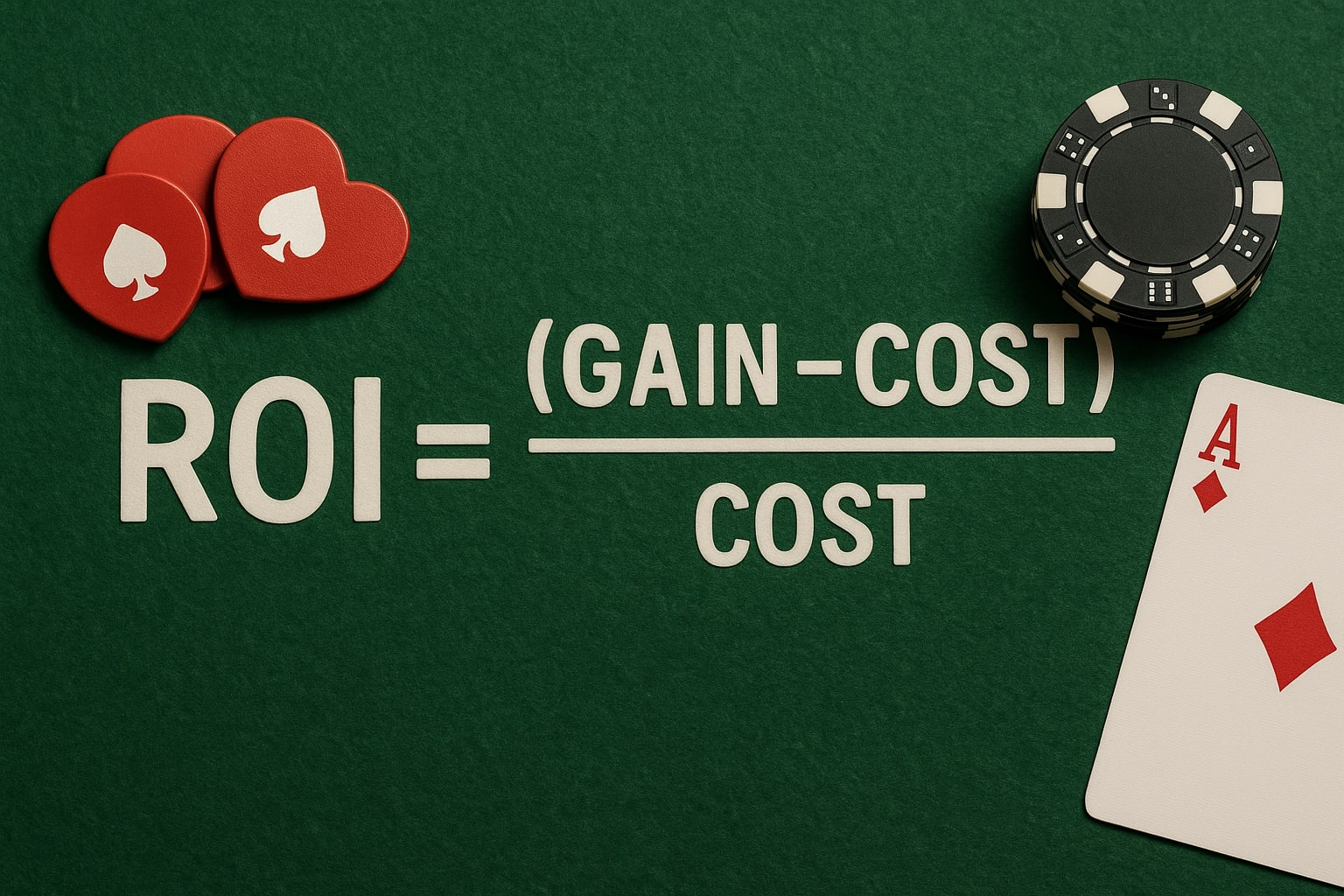Tracking your return on investment (ROI) in casino marketing isn’t just a best practice—it’s how you find what’s working, cut the waste, and scale the wins. But let’s be real: between multiple campaigns, player types, and channel costs, it’s not always straightforward.
Whether you’re managing online casino ads, running a loyalty program, or promoting an event at a land-based property, understanding ROI on casino marketing is what separates smart marketers from lucky ones.
In this guide, you’ll learn exactly how to track ROI for casino marketing—from setup to reporting—using practical steps that work in 2025. You’ll also discover common mistakes to avoid and tools you can use, whether you’re running a small campaign or managing millions in monthly ad spend.
 What Is ROI in Casino Marketing?
What Is ROI in Casino Marketing?
Return on Investment (ROI) is the metric that shows how much profit you made compared to how much you spent on a marketing campaign. It tells you whether the effort and money you put into a campaign paid off.
The basic ROI formula is:
Why It Matters:
In casino marketing, ROI is not just about one-time gains. It’s about long-term player value, loyalty, and repeat visits. When you accurately track ROI, you can:
- Prove which campaigns bring real profit.
- Justify increased budgets.
- Cut underperforming promotions.
- Make smarter decisions in real time.
Why ROI Matters in 2025
Marketing in the casino industry has evolved. With rising ad costs, privacy regulations, and competition from crypto and mobile casinos, knowing your ROI isn’t optional.

Key reasons ROI is critical now:
- Ad Restrictions: Google, Facebook, and regional laws have tightened their policies on gambling ads.
- Multi-Touch Journeys: Players now discover casinos across platforms—influencers, forums, TikTok, etc.
- Tech-Driven Campaigns: AI-driven personalization, gamified CRM systems, and retention automation demand better data.
- Investor & Partner Expectations: Stakeholders want numbers, not guesses.
Understanding ROI on casino marketing gives you control and insight—two things every operator needs in today’s fast-changing market.
Step-by-Step: How to Track ROI on Casino Marketing
1. Set Clear Goals
Before tracking ROI, define why the campaign exists.
Ask yourself:
- Are you acquiring new depositors?
- Trying to reactivate lapsed users?
- Promoting a seasonal bonus or event?
- Driving VIP engagement?
Each goal should have clear conversion events tied to it. For example:
- First deposit made.
- Loyalty card swiped.
- Event registration completed.
Clarity upfront = easier ROI math later.
2. Define Your Player Value
ROI means little if you don’t understand the value of the player you’re acquiring. This is where metrics like LTV (lifetime value) and ARPU (average revenue per user) come in.
Ask:
- How much does a typical player spend over 30/90/365 days?
- How much do VIPs spend?
- What’s the average deposit per user?
Segment players:
- New users (e.g., $80 in the first month)
- Returning/reactivated (e.g., $150)
- VIPs (e.g., $2,000+ over 6 months)
3. Track Campaign Costs
This includes:
- Paid ad spend (Google, Facebook, DSPs)
- Creative production (designers, editors, voiceover talent)
- Influencer fees and affiliate commissions
- Software/platform fees (RedTrack, CRM tools)
- Staff or agency time
Don’t forget hidden costs like promo code discounts, free spins, or giveaways that affect revenue.
4. Use Proper Tracking Tools
You need to know where players came from and what they did. This is impossible without attribution.
For Online Campaigns:
- UTM links
- Google Analytics 4 + CRM sync
- Postback URLs for affiliate traffic
- AppsFlyer or Adjust for mobile app installs
For Land-Based Casinos:
- Unique QR codes on print promos
- Promo code redemptions at cage
- Loyalty cards linked to campaigns
- POS and CRM integrations
Combine offline and online data for hybrid tracking.
5. Calculate ROI
Now that you have your revenue and costs:
Example:
- Revenue: $25,000
- Cost: $7,000
ROI = (25,000 – 7,000) / 7,000 × 100 = 257%
High ROI? Scale it. Low ROI? Optimize or kill the campaign.
6. Compare Campaign Performance
Once you’ve calculated ROI, break it down further:
- By channel (paid, social, email, influencers)
- By offer (cashback, bonus spins, free entry)
- By region (different jurisdictions behave differently)
This helps you double down on what works best.
7. Watch Retention & LTV
ROI should not stop at first conversion. Especially in casino marketing, long-term value matters.
Track:
- Day 1 / Day 7 / Day 30 retention
- Repeat deposit frequency
- VIP upgrades
- Average revenue after 3 months
A campaign might have modest short-term ROI but sky-high LTV—making it a hidden gem.
Common Mistakes to Avoid
- Tracking clicks but not deposits. CTR doesn’t mean revenue.
- Not connecting CRM with marketing data. That’s where LTV insights live.
- Overvaluing new players. Returning players are often more profitable.
- Ignoring retention. 40% of ROI can come after the first 30 days.
- Using only one attribution model. Use blended or data-driven models for accuracy.
Top Tools to Track ROI on Casino Marketing
| Tool | Description | Best For |
|---|---|---|
| Google Analytics 4 | Web & event tracking | Online casino websites |
| RedTrack | Affiliate tracking + multi-touch attribution | Campaigns with affiliates |
| AppsFlyer | Mobile app installs + post-install tracking | iOS/Android casinos |
| Optimove | CRM + behavior analysis | Long-term LTV tracking |
| Tableau / Looker Studio | Custom dashboards | Visual ROI reports |

Visual Reporting Example
Monthly ROI Report: Blackjack Bonus Campaign
| Channel | Spend | Revenue | ROI | CPL | VIP Conversions |
| Facebook Ads | $5,000 | $19,000 | 280% | $8.50 | 12 |
| $800 | $6,400 | 700% | $3.10 | 5 | |
| Influencer | $2,200 | $9,200 | 318% | $11.70 | 7 |
FAQs
How do I calculate ROI on casino marketing?
Use: (Revenue – Cost) / Cost × 100. Just make sure you’re tracking real player value, not just leads or clicks.
What’s a good ROI for a casino campaign?
200%+ is strong for acquisition. Retargeting and retention campaigns may show lower initial ROI but higher LTV.
How can I track ROI for offline campaigns?
Use promo codes, QR codes, and loyalty systems that tie back to the campaign source.
Which tools are best for tracking ROI?
Start with GA4, your CRM, and campaign tagging. Add RedTrack or Optimove for deeper analysis.
Does influencer marketing have trackable ROI?
Yes—just assign a unique bonus code, UTM, or landing page to each creator.
Conclusion
If you’re not tracking ROI on casino marketing, you’re flying blind. In 2025, with AI-powered personalization, evolving regulations, and increasing acquisition costs, ROI gives you clarity, direction, and control.
By following the steps above—setting goals, knowing player value, tracking costs, and using the right tools—you’ll be able to spot winners, cut losers, and build smarter campaigns.
Want more ROI-friendly casino growth strategies? Subscribe to our newsletter or bookmark this guide for future reference.



